|



|
FROM SITE SELECTION
MAGAZINE, MAY 2022 ISSUE
|
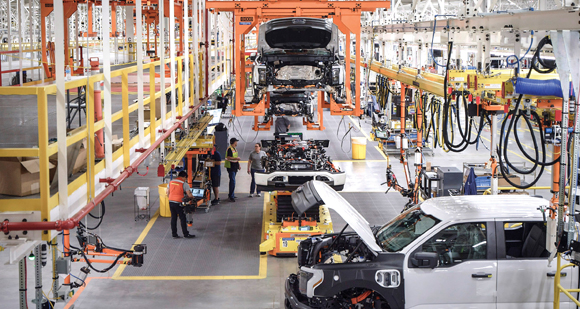
|
NORTH AMERICAN AUTOMOTIVE
Even before a $5.5 billion blockbuster was announced last week by
Hyundai in Savannah, the EV revolution was in full power drive across
the continent, as these project snapshots reveal.
|
|

|
INVESTMENT PROFILE: GREATER PHILADELPHIA
“Philadelphia is the center of the country for cell and gene therapy,”
Drexel University President John Fry tells Site Selection. Find out why.
|
|
|
CONWAY ANALYTICS
SNAPSHOT
|
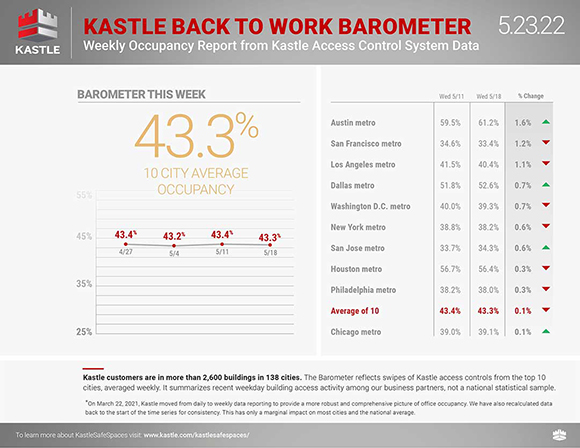
Chart courtesy of Kastle Systems
|
|
“Class A buildings are driving net absorption rates in many parts of the
country, such as the Sun Belt, and firms consider quality office space
necessary to attract skilled employees,” says the latest NAIOP Office
Space Demand Forecast, published yesterday by the NAIOP Research
Foundation. “Suburban markets and life sciences hubs are recovering
better than the national average as more employers embrace a return to
the office and the pandemic eases. According to Kastle Systems data on
office utilization, office occupancy across the 10 U.S. cities that the
company tracks reached 43.4% on April 27, a new record since the
pandemic began.”
The graphic above from Kastle Systems shows those 10 cities’ office
occupancy trends in Kastle’s latest report from early this week.
Compare and contrast the performance of those metro areas and others in
Site Selection’s Top Metro rankings from March 2022, March 2021 and March 2020. The strongest upward mover in
Kastle’s analysis is Austin, which this year tied for No. 4 among Site
Selection’s Tier 1 Top Metros with 208 qualifying projects, dramatically
up from 84 the year before and 95 the year before that.
Of the overall upward trend, Thomas J. Bisacquino, president and CEO of
NAIOP, said, “We are fortunately seeing that even as the work week gets
reshuffled, and fewer employees are in the office at one time, companies
still seek spaces for collaboration and for all employees to be at the
office at least part of the week.” — Adam Bruns
|
|
  |
Georgia
At nearly the same hour that U.S. Commerce Secretary Gina M. Raimondo
hosted a trade and investment roundtable in Seoul with Korean Minister
of Trade, Industry and Energy Lee Chang-Yang and U.S. and Korean
executives from companies including Hyundai, high-ranking Hyundai
executives last Friday were in the hot and steamy Lowcountry of Bryan
County, Georgia, near Savannah, to mark a new investment watermark for
Georgia: Hyundai’s first EV plant in the U.S., expected to cost $5.5
billion and create 8,100 jobs. Another $1 billion in investment is
expected from suppliers. The plant will be located on a 2,293-acre
megasite along I-16, 28 miles inland from Savannah, that was assembled
by the Savannah Harbor-Interstate 16 Corridor Joint Development
Authority, formed in 2015 by Chatham, Bryan, Bulloch and Effingham
counties to attract a project exactly like this one. The effort is
similar to the four-county JDA that attracted then-Baxter International a decade ago
and Rivian’s own $5 billion plant this year to the
Stanton Springs area east of Atlanta along I-20. Watch for more coverage
of the Hyundai project in this space and in the pages of Site Selection
magazine.
Ecuador
Barry Callebaut this week announced it is supplementing its global
network of more than 30 R&D centers by establishing a “Farm of the
Future” in Ecuador. Noting the country’s historical cultivation of
coffee, bananas and shrimp, the company said it’s also “the world’s
third-largest cocoa producer and one of the fastest-growing cocoa
origins, as well as the largest global producer of fine flavor cocoa.
Combined with our long-established expertise in innovation and
sustainability, Ecuador is the perfect match for Barry Callebaut to
build a dedicated hub to power cocoa farming research to support cocoa
farming resilience and productivity.” The 640-hectare (1,581-acre)
property is located in the Cerecita Valley between Guayaquil, the
country’s largest city, and the Pacific Ocean. “Operations and
infrastructure development will start immediately with the planting of
cocoa seedlings on the farm’s 400 hectares of non-planted land.,” the
company said. “Integration of high-yielding and maximum flavor varieties
in the planting design will also support cross-learning between cocoa
farms of all sizes, in different locations and climates from around the
world.” Farm of the Future is geared toward realizing the company’s
Forever Chocolate plan to make sustainable chocolate the norm by 2025.
|
|
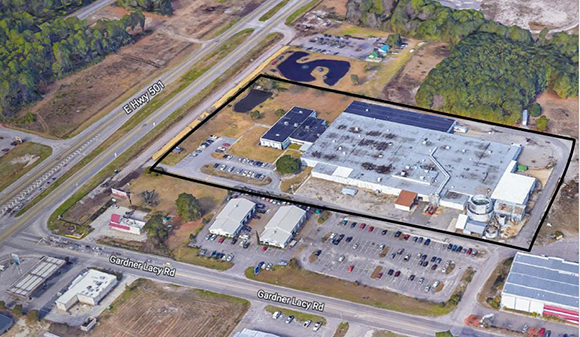 |
|
Look no further than the 127,535 SF Wolverine Brass Manufacturing
Warehouse in Horry County, South Carolina. Located in the Myrtle Beach
MSA, which according to US Today was the fastest growing MSA in the
country in 2021, you should have no problem finding the workforce you
need to fulfill your operations.
The building features 114,535 SF of climate-controlled space, 13,000 SF
of office space, a gravel storage/lay down yard, a 200,000 gallon
containment tank, five (5) 12’ x 12’ dock doors with levelers, eight (8)
truck doors of various sizes, and 11.42 acres surrounding the building.
Not to mention this building is only three miles from Coastal Carolina
University and Horry Georgetown Technical College, giving you excellent
access to the next generation of workers and state-of-the-art training
facilities.
Want to know more? Contact the North Eastern Strategic Alliance (NESA)
at info@nesasc.org or at 843-661-4669.
|
|
|
TEXAS ECONOMIC
DEVELOPMENT GUIDE 2022-2023
|
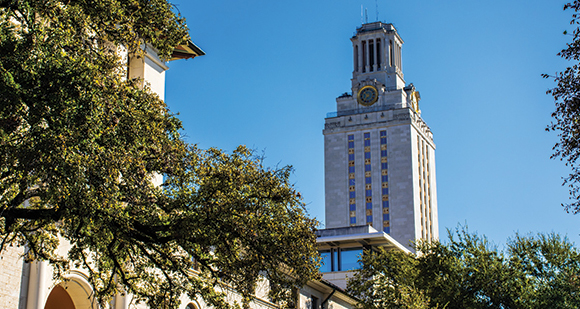
|
HIGHER EDUCATION
Updates on the state’s six public university systems illustrate how
Texas opens the door to opportunity for a legion of future
professionals.
|
|
|
SITE SELECTION
RECOMMENDS
|
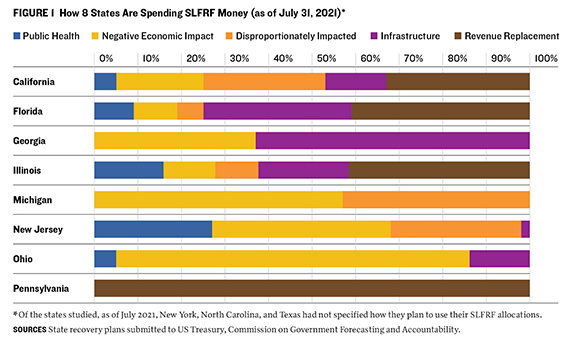
Graph courtesy of Volcker Alliance
Click Here to Enlarge
In April, the Volcker Alliance released “The $195 Billion Challenge: Facing
State Fiscal Cliffs After COVID-19 Aid Expires” in partnership with Beverley
S. Bunch. The paper finds that at least three of the 11 most populous U.S.
states — California, Pennsylvania and Illinois — may face significant
spending challenges after federal pandemic aid under the American Rescue
Plan Act of 2021 (ARPA) expires by the end of 2026. “Fiscal cliffs, or
sudden and severe economic decline, may loom if states use their budgetary
relief funds for ongoing expenditures, such as long-term policy initiatives,
instead of one-time costs, like infrastructure projects,” the Alliance says.
Preliminary filings on relief fund allocations required by the US Treasury
Department are inconsistent and lack transparency, limiting the ability of
decision-makers, researchers, and the public to evaluate implications of
$195 billion in federal pandemic economic recovery cash provided to states
under ARPA.” This link takes you to the full paper including
individual state analyses. There is also a related webinar.
|
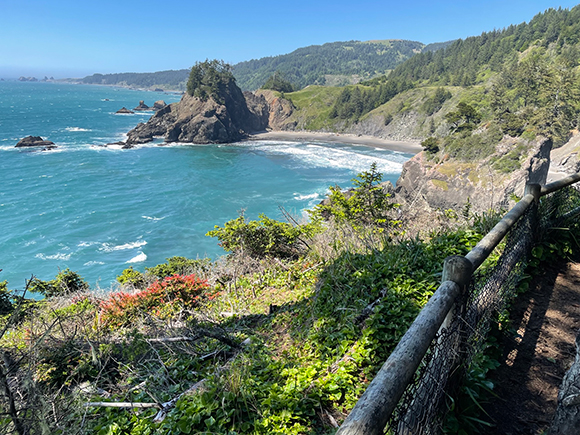
|
Site Selection Art Director Scott Larsen this week made this image of
the Arch Rock Area in the Samuel H. Boardman State Scenic Corridor,
located between Brookings and Gold Beach along Highway 101 in Oregon.
The state parks site notes that “this stretch of the highway features
one turnoff after another, each with access to picnic areas, viewpoints
and trailheads that connect an 18-mile segment of the Oregon Coast
Trail.” The park is named for the first Oregon State Parks
superintendent, who served from 1929 to 1950 and worked tirelessly to
assemble a coastal park. Lands were acquired from private landowners and
from the U.S. Bureau of Land Management between 1949 and 1957, and
included a donation by Borax Consolidated, Ltd. of 304.1 acres for the
park and 62.9 acres for right-of-way on the relocated Oregon Coast
Highway.
|
|
|
|

